Kiteboard Leashes: Key Gear for Safety and Performance
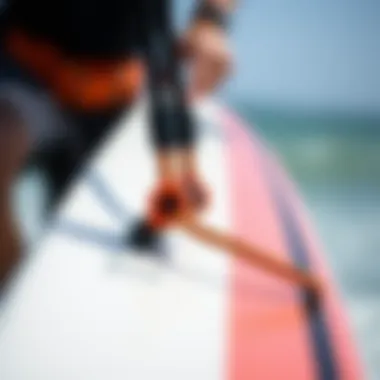
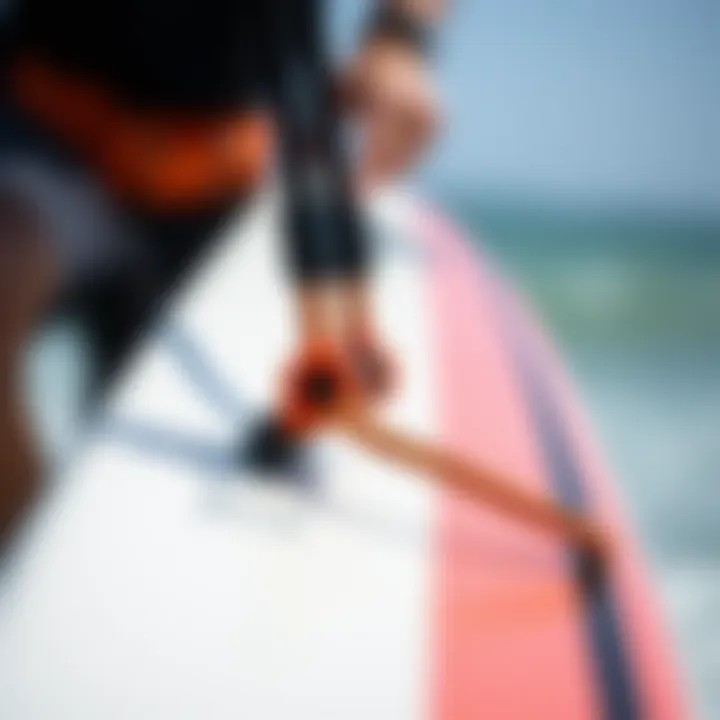
Intro
In the world of kiteboarding, where the wind drives adrenaline and water becomes the playground, kiteboard leashes play a pivotal role in ensuring both safety and performance. These seemingly simple pieces of equipment can mean the difference between a thrilling ride and a potentially perilous encounter with unpredictable elements. Understanding the nuances of kiteboard leashes is essential for anyone who seeks not just to ride the waves but to navigate them effectively.
With the wind fluttering and the kite dancing overhead, novices and seasoned kiteboarders alike must grasp how crucial leashes are. They tether the board to the rider, preventing it from becoming a runaway projectile in the event of a wipeout. Beyond just safety, a well-chosen leash contributes to riding finesse and control, allowing enthusiasts to push their limits without losing connection to their boards.
Throughout this article, we will break down the various types of leashes available, discuss how to maintain them properly, and explore the implications for rider safety. Not to be overlooked is the importance of integrating the right leash with your kiteboarding gear; this element alone can have a profound effect on performance. By the end of this exploration, readers will not only have a basic understanding of kiteboard leashes but will also appreciate their significance in elevating the kiteboarding experience.
Intro to Kiteboarding Gear
Kiteboarding is more than just a sport; it’s a thrilling dance between wind, water, and board that captivates enthusiasts around the globe. At its core, kiteboarding gear plays an essential role in determining the experience of each rider. Understanding the various components becomes crucial for both novice kiteboarders and seasoned veterans alike. This section sets the stage for an insightful exploration of kiteboard leashes and their significance among all pieces of equipment.
Having the right gear, particularly the leash, can be a game changer. It can keep you safe, enhance your performance, and ultimately determine how much fun you’ll have on the water. Engaging with the intricacies of kiteboarding gear leads to informed choices, which directly impact the rider’s safety and overall experience.
Understanding the Basics of Kiteboarding
Diving into the basics is like getting your feet wet before taking the plunge. Kiteboarding involves several key components: the kite, the board, the harness, and of course, the leash. Each element fits into the larger puzzle, working in harmony to create a delightful flow during rides. The most fundamental aspect of kiteboarding involves understanding how these elements interact with one another.
- Kites facilitate lift and maneuverability. The type of kite and its sizing significantly influence the rider's capability to handle different wind conditions.
- Boards vary in size and shape, often tailored for particular styles or conditions, such as big air or freestyle.
- Harnesses connect the rider to the kite, with fit and comfort being critical to performance.
These elements, while essential, mean little if not paired with a proper leash. The leash's role ties all these elements together, functionally anchoring the rider during intense moments, thus ensuring safety and convenience.
The Importance of Equipment Safety
When it comes to adventure sports like kiteboarding, safety often takes center stage. This is particularly true in kiteboarding where strong winds and expansive waters can create unpredictable situations. The significance of the leash cannot be understated here; it plays a pivotal role in enhancing rider safety. When you're zipping across the waves or catching air, a reliable leash can make the difference between a thrilling ride and a potentially dangerous fall.
A few considerations about safety through equipment include:
- Ensuring your leash is the right length, material, and attachment style for your riding style.
- Regular inspections of your gear for wear and tear to minimize unexpected failures.
- Staying updated on safety protocols relevant to your local riding spots.
"Safety doesn’t come from just wearing gear; it comes from understanding how to use it effectively."
In summary, the right equipment—particularly the leash—enhances not only performance but equally emphasizes the importance of safety in kiteboarding. By grasping the fundamentals of your gear, every rider can elevate their experience on the water, turning an exhilarating hobby into a safe and enjoyable adventure for everyone.
The Role of the Kiteboard Leash
Kiteboarding is as much an art as it is a science, and at the heart of this exciting sport lies equipment that directly influences safety and performance. The kiteboard leash is one such essential piece of gear that cannot be overlooked. It functions as a direct link between the rider and the kite, serving several key purposes that bolster both enjoyment and safety during rides.
Understanding the role of the leash is crucial because it has a significant impact on how riders interact with their kites. Without the leash, riders would lose complete control over their equipment in adverse situations, which can lead to dangerous consequences. A well-designed leash acts as a lifeline, ensuring that the rider remains connected to their kite, and helps in avoiding potential mishaps.
Primary Functions of the Leash
The primary function of the kiteboard leash is to keep the rider attached to the kite at all times. This may sound straightforward, but it’s vital for managing safety during a session. When a rider takes a tumble or experiences unexpected turbulence, the leash helps keep the kite within reach, maintaining control and preventing it from becoming a problem.
Beyond mere attachment, there are several functionalities that distinguish leashes:
- Security: The leash adds an extra layer of security. It helps prevent the kite from drifting away if a rider is thrown into the water.
- Simplified Recovery: In the event of losing balance, a rider can easily grab the leash to regain control over the kite, making recovery less daunting.
- Pathway to Safety: It often incorporates a quick-release mechanism, allowing the rider to detach from the kite rapidly if they find themselves in a sticky situation. This feature is critical for safeguarding against injuries from tangles or excess force.
Enhanced Control During Rides
Leashes also play a critical role in enhancing overall ride control. The connection provided by the leash allows riders to generate power and manage their kites with precision. Properly fitted leashes allow for swift maneuvers and adjustments, which are essential during high-speed turns or when performing tricks. It's this level of control that can make or break a ride—too much slack could leave you feeling disconnected upon sudden gusts, while too little could lead to overwhelming force against the rider.
In addition to supporting aerial tricks, leashes help in maintaining stability during transitions. For those venturing into choppy waters or gusty winds, the leash acts as a stabilizing force, ensuring that the rider's movements are in sync with the kite's dynamics. A mismatch here can lead to frustrating, if not dangerous outcomes.
A well-chosen and properly maintained leash not only keeps you safe but also enhances your performance as a kiteboarder. It's a tiny yet mighty piece of gear that every kiteboarder should regard with the utmost respect.
For further insights on kiteboarding safety and gear, resources like Wikipedia or Reddit can offer valuable information.
Types of Kiteboard Leashes
When it comes to kiteboarding, the importance of the right leash cannot be overstated. Kiteboard leashes play a vital role in the safety and performance of riders, acting as a critical tether between the rider and the kite. Understanding the various types of kiteboard leashes can help you choose the one that best matches your personal style and riding conditions. Here are the three primary types of kiteboard leashes: fixed leashes, quick release leashes, and leashes with safety features.

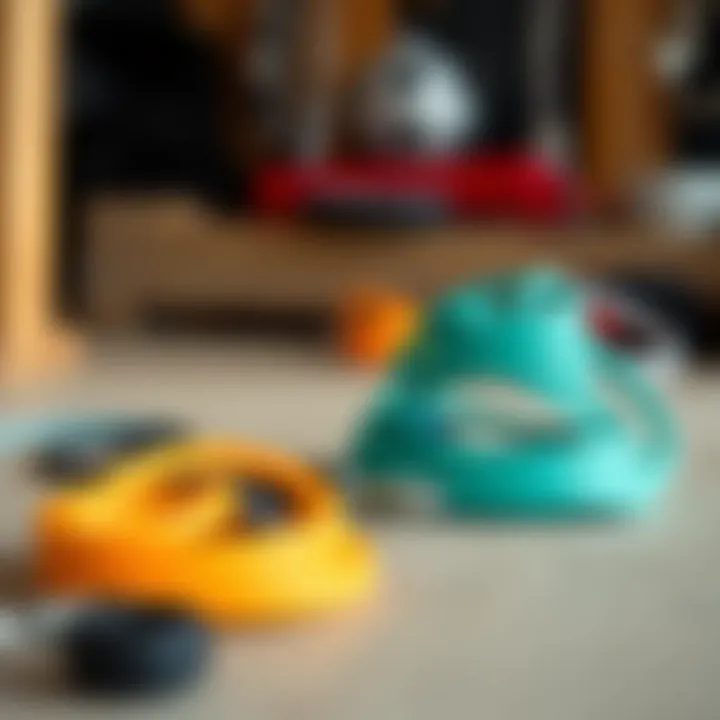
Fixed Leashes
Fixed leashes are the simplest and often most reliable type available. They run directly from your harness to the kite, creating a stable connection that allows minimal movement. This fixed nature can be advantageous, especially for those who tend to ride in higher winds and perform tricks where a solid connection is essential.
Some benefits of using fixed leashes include:
- Simplicity: There's little to no mechanism to fail, making them less prone to issues in harsh conditions.
- Direct Control: They provide immediate feedback from your kite, which can enhance your control during aerial stunts.
- Weight: Generally lighter than their counterparts, fixed leashes don’t add as much bulk to your setup.
One downside, however, is the lack of a quick release option. In an emergency, getting rid of the kite quickly might be challenging. For this reason, fixed leashes tend to be favored more by seasoned kiteboarders who have greater confidence in their skills.
Quick Release Leashes
Quick release leashes are designed with a mechanism that allows you to detach from the kite almost instantaneously. This design feature is particularly beneficial in emergency situations where control is compromised. The ability to detach without excessive fuss can be the difference between a close call and a serious accident.
Advantages of quick release leashes include:
- Safety: They empower a rider to remove the kite quickly, allowing for a swift escape from potential danger.
- Versatility: Many quick release systems are adjustable, accommodating varying wind conditions and the rider’s experience level.
- Ease of Use: They allow for quick adjustments on the fly, suitable for riders looking to change their settings mid-session.
However, be mindful that these leashes come with more components and can sometimes lead to mechanical failure if not properly maintained.
Leashes with Safety Features
The most innovative options take safety to the next level by offering additional built-in safety features. These leashes are typically equipped with some form of redundancy or enhance the release capabilities.
Common aspects to consider about leashes with safety features:
- Automatic Release Mechanisms: Some styles include safety systems that release automatically under certain tension scenarios, especially beneficial in high-stress situations.
- Enhanced Visibility: Many brands integrate bright colors or reflective materials into leash designs, which can be a helpful feature for identification in crowded or low-light conditions.
- Built-in Buoyancy: Some leashes are designed to float, making it easier to retrieve after a spill.
While these leashes often come at a premium cost, they can offer peace of mind, especially for riders frequently navigating challenging conditions.
As you navigate through the various options, it's essential to choose a leash that not only meets your performance demands but also aligns with your safety preferences. Remember, when it comes to enjoying the thrill of kiteboarding, having the right gear, including a well-suited leash, can significantly enhance both your ride and safety.
"Choosing the right kiteboard leash is crucial; it is the lifeline that connects you to the kite while taming the winds."
For more resources on kiteboarding gear, you can explore Wikipedia and Britannica for in-depth information.
Choosing the Right Kiteboard Leash
Choosing the right kiteboard leash goes beyond just picking something off the shelf. This component is critical for your safety and performance while on the water. A well-chosen leash aligns with your riding style, the conditions you face, and the features that best meet your needs. Understanding the elements that influence your decision can be the difference between a smooth ride and a potential mishap.
Assessing Riding Conditions
Before selecting a leash, it’s essential to evaluate the riding conditions you will encounter. Factors such as wind speed, water chop, and location (i.e., a flat landscape or wave-heavy area) significantly influence the choice of leash.
- Wind Speed: Higher winds often demand stronger, more robust leashes that can handle the added stress without snapping. A leash meant for lighter winds might not hold up well during a gusty session.
- Water Conditions: In choppy waters, a leash with some elasticity might be beneficial. It can provide a buffer against sudden pulls that can occur when hitting waves. Conversely, flat water riding may require a stiffer leash to maintain control and reduce drag.
- Location: If you often ride in crowded areas where the risk of getting tangled with others exists, a shorter leash might be suitable. In contrast, remote spots that allow for more freedom could work better with a longer leash for added range.
Evaluating Personal Riding Style
Your individual riding style plays a significant role in selecting the right kiteboard leash. Are you into freestyle, wave riding, or perhaps cruising on flat waters? Each style has its nuances that dictate leash requirements.
- Freestyle Riders: If you’re a freestyle enthusiast, a leash that allows quick releases is crucial. You want to separate from your board easily when attempting tricks or during falls to minimize the risk of injury.
- Wave Riders: For wave riding, durability is key. A leash designed for the surf often includes features that help it stay attached through heavy impacts, all while providing enough flexibility for various maneuvers.
- Recreational Riders: If you’re riding just for the thrill without hardcore tricks or styles, a straightforward leash with good length and a quick-release function will likely suffice. It should be reliable yet not overly complex.
Remember: A well-chosen leash can enhance your ride significantly, while a poor choice could lead to uncomfortable situations at sea.
For further information on kiteboarding safety gear, check out related resources on Reddit and Wikipedia.
Maintenance of Kiteboard Leashes
Maintaining your kiteboard leash is not just a routine task; it’s a vital practice that determines your safety and performance each time you hit the water. Kiteboarding can be as unpredictable as the weather, and your leash is your lifeline. Neglecting its upkeep can lead to serious mishaps, which can be easily avoided with regular attention.
Regular Inspection and Care
A well-maintained leash can prevent accidents and enhance your overall riding experience. Regular inspections should be part of your pre-ride checklist, and it’s a simple process. Each time you take your gear out, examine the leash for wear and tear. Look for signs of fraying, especially near the connection points, as this can weaken the leash significantly.


- Check all connections: Ensure that both ends of the leash securely attach to your harness and the board. Any looseness could lead to losing your board at a critical moment.
- Look for discoloration: Fabric and materials can deteriorate in the elements, and fading colors can be a clue that it’s time for a replacement.
- Feel for softness: A leash should be sturdy yet flexible. If it feels brittle or overly soft in particular areas, it might be due for retirement.
Taking care of your leash isn’t just about checks; it also involves cleaning it regularly. Rinse your leash with fresh water after each session to remove salt and sand. Allowing debris to build up can increase wear and excessively shorten its lifespan.
Storing Your Leash Properly
How you store your kiteboard leash can greatly affect its durability. A leash carelessly tossed in your garage is akin to leaving a fine wine uncorked; it won’t last long. Develop a practice of storing your leash in a cool, dry place after every session. Here are some tips:
- Use a dedicated bag: Keep your kiteboarding gear together, and designate a compartment for the leash. This will prevent tangling with other equipment.
- Avoid direct sunlight: Prolonged exposure to UV rays can weaken the materials used in your leash. Store it in a dark spot if possible.
- Roll, don’t fold: Instead of folding the leash, roll it up gently. This reduces stress on the connection points and avoids unnecessary creases in the material.
By following these maintenance practices, you ensure that your leash remains reliable when you need it most. It’s about peace of mind; knowing that you’ve taken all the right steps to keep your gear up to par. Remember, a little forethought can go a long way in kiteboarding, making your experience safer and more enjoyable.
Safety Protocols Related to Leashes
In the world of kiteboarding, understanding the safety protocols associated with leashes is of utmost importance. These protocols not only enhance the performance of the rider but significantly reduce the risk of accidents, ensuring a safer experience on the water. Having a solid grasp of these safety measures can be the difference between a fun day on the waves or a potentially dangerous situation. Here are some key considerations:
- Awareness of Surroundings: Always be aware of your surroundings before launching or landing your kite. This includes fellow riders, other watercraft, and any obstacles.
- Proper Leash Attachment: Always ensure that your leash is securely attached to both your harness and board. A loose or improperly connected leash can cause serious injuries or equipment loss.
- Regular Checks: Regularly inspect your leash for signs of wear and tear, such as fraying or damage. This maintenance is essential for your safety and performance.
"In kiteboarding, a moment's inattention can lead to accidents. Your leash is only as strong as its weakest point."
Understanding Release Mechanisms
A critical component of kiteboarding safety protocols is comprehending the release mechanisms of your leash. These mechanisms are designed to detach quickly from your board or harness during an emergency, potentially averting accidents caused by entanglements or loss of control. Understanding how your leash's release mechanism functions can save you in dire situations. Most modern leashes come equipped with either a quick-release, which can be activated with a simple pull, or a more traditional Velcro system. It’s crucial to familiarize yourself with the specific mechanism on your leash, as procedures can differ between models:
- Practice Engaging and Releasing: Spend some time on land practicing how to activate the release mechanism. Doing so will instill confidence when you’re out on the water.
- Know the Limitations: Be aware of how and when to use the release. Over-reliance on it can lead to complications if not understood properly.
Responding to Emergencies
Despite rigorous preparations, emergencies can still arise while kiteboarding. Being equipped with a response plan is equally as vital as having the right gear. First and foremost, always remain calm. Panic can lead to poor decision-making. Here are steps to consider if you're faced with an emergency:
- Release Your Leash: If you find yourself tangled or overpowered by the kite, deploy your release mechanism swiftly. This helps in regaining control and reduces the risk of drowning.
- Signal for Help: If you’re in a precarious position, signal to others in the area. A raised arm or waving your board can catch attention.
- Understand the Environment: Being aware of the tidal patterns and local hazards can aid in navigating your way back safely.
- Stay Calm and Assess Your Surroundings: Once you’re clear, assess your surroundings to ensure it’s safe to re-engage with your session.
By understanding the protocols related to leashes, kiteboarders can mitigate risks associated with their sport. It's a crucial step that combines knowledge with practical skills to ensure a comprehensive approach to safety.
Integrating Leashes with Other Gear
In the realm of kiteboarding, integrating leashes with other essential gear is paramount for both optimal performance and safety. Kiteboarding is a symphony of various elements working together harmoniously. Just as a conductor aligns musicians, kiteboarders must ensure their gear operates in unison to create seamless riding experiences. A proper integration can mean the difference between a thrilling session on the water and potential hazards during unexpected situations.
Pairing Leashes with Harnesses
When selecting a leash, one cannot overlook the relationship between the leash and the harness. Harnesses are the central hub where the rider connects with the kite, and the leash complements this by providing security and control. The leash's attachment point must be carefully chosen to ensure it aligns perfectly with the harness connection. If not, it can lead to discomfort or even accidents.
Benefits of a well-paired leash and harness include:
- Stability: A snug fit avoids unwanted slack, which may compromise control.
- Freedom of Movement: The right leash allows for full range of motion without hindrance.
- Quick Release Capability: In emergencies, both harness and leash should work together to allow for swift disengagement from the kite, ensuring safety.
To achieve better bonding between the leash and harness, consider adjusting the settings of the harness to make sure the leash is oriented correctly. Misalignment can lead to a cumbersome experience, especially during maneuvers.
Compatibility with Different Boards
The dynamic nature of kiteboarding also extends to the board. Different boards have different designs, which alter how the leash interacts with the gear as a whole. For instance, surf boards often accommodate leashes designed for specific riding styles, while freeride boards might require a more robust approach to handle the rigors of higher speeds.
Key considerations for leash compatibility with boards include:
- Attachment Points: Boards typically come with dedicated attachment points for leashes. Ensuring the leash is connected to these points enhances safety and prevents mishaps.
- Length of the Leash: Too short of a leash can hinder mobility, while too long may result in increased drag. Riders should ensure that the length suits the style of riding they plan to engage in.
- Material and Design: Some boards are designed with specific leash attachment mechanisms. The leash should not only be durable but also able to accommodate the board's unique style and function.
"Selecting the wrong leash for your board can lead to a jarring experience that resembles trying to tie shoelaces on a moving train. Focus on fit and function to navigate smoothly."
In the end, attention to detail when integrating leashes with other gear reflects a kiteboarder's commitment to safety and enhanced performance. Understanding and implementing these considerations allows riders to fully enjoy the thrilling experience kiteboarding offers, with the confidence that their gear is working as it should.
Kiteboarding Leashes Across Different Riding Styles
In kiteboarding, the style of riding one prefers significantly influences the choice of gear, particularly the kiteboard leash. As riders evolve, they often find that the leash must adapt to fit not only their personal preferences but also the specific demands of various conditions and riding types. Understanding how leashes function across different styles can make a notable difference in both safety and performance. This section explores the unique considerations relevant to freestyle riding and wave riding, ensuring you have the knowledge to select the ideal leash for your kiteboarding adventures.
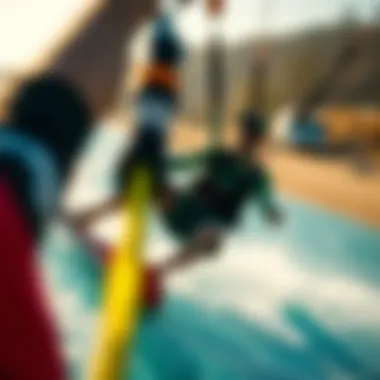
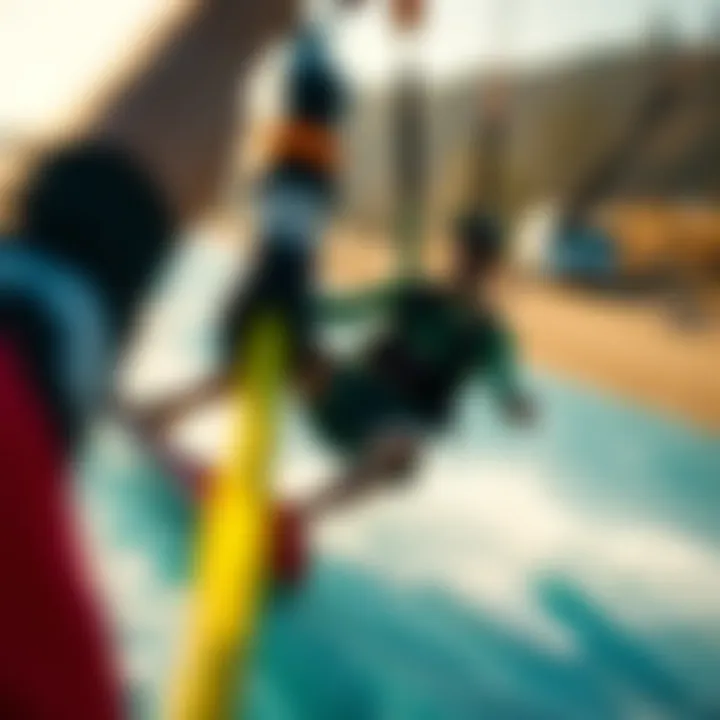
Freestyle Riding Considerations
Freestyle riding is characterized by innovative tricks and aerial maneuvers, requiring both agility and precision. When it comes to choosing a leash for this riding style, certain aspects stand out.
- Length and Flexibility: Riders often prefer shorter leashes that reduce drag while allowing for freedom of movement. If the leash is too long, it can hinder trick execution, particularly during rotations or transitions. Hence, many freestyle kiteboarders opt for a leash that is about 3 to 4 feet long, balancing the need for control with maneuverability.
- Material Strength: Given the dynamic nature of freestyle tricks, the leash should be crafted from robust materials capable of withstanding repetitive strain. Using high-tensile strength cord helps ensure that the leash won’t snap during high-pressure moves.
- Quick Release Mechanisms: Safety is paramount, especially when attempting higher risk tricks. A leash equipped with an efficient quick release allows riders to detach swiftly in case of an emergency. For instance, if a rider loses control or gets entangled, being able to disconnect rapidly saves one from potential injuries.
- Flexibility in Attachment Points: Some freestyle leashes come with adjustable attachment options. This feature allows riders to connect their leash in a manner that suits their specific trick. Having that flexibility could determine success or failure, especially during complex maneuvers.
Wave Riding Needs
Wave riding encompasses a whole different realm of challenges, with the ocean's unpredictable nature and the need to maneuver through surf. The considerations for leashes in this style reflect the environment and the unique requirements of wave riders.
- Durability Against Elements: Waves can wear down gear quickly, so it’s essential to select a leash that is resistant to saltwater and UV exposure. Materials like neoprene or reinforced nylon are favorable choices. This ensures longevity when pitted against crashing waves and sun glare.
- Swivel Attachment: In wave riding, frequent changes in direction are common. Opting for a leash with a swivel prevents twists and tangles, allowing for a smoother and more liberated riding experience.
- Safety Breakout: Like freestyle, wave riding can also present perilous situations. A leash meant for this environment typically includes a safety breakout feature; this allows the rider to separate from the board quickly should they find themselves in a critical position, like being smashed against rocks or held underwater.
- Leash Length and Design: Wave riders might prefer slightly longer leashes that provide enough distance to avoid getting tangled with the board while still maintaining control. A common length is about 6 feet for boards designed specifically for waves. However, some riders can opt for shorter versions, depending on their personal preference and style.
Ultimately, the right leash for each riding style positively contributes to performance and safety. By considering the nuances of freestyle and wave riding, kiteboarders can enhance their riding experience and minimize risks, allowing them to focus on enjoying their time on the water.
Whether you’re ripping through waves or soaring high in the sky, matching your leash choice to your riding style is vital. Adapting to the specific demands of each conditions uplifts not just fun on the water, but also your confidence in your gear.
Innovations in Kiteboard Leash Technology
In the world of kiteboarding, technology is continually evolving, enhancing both performance and safety. Innovations in kiteboard leash technology are among the most significant trends in this landscape. These advances are not merely cosmetic; they drive the way riders control their kites while riding and how they respond to potentially hazardous situations.
As kiteboarding becomes more popular, manufacturers are compelled to rethink materials and design. These innovations lead to leashes that are not only lighter but also stronger, addressing long-standing concerns about durability and reliability in varying conditions.
From new materials that resist wear and tear to design features that adapt to diverse riding styles, the improvements are centralized around two core areas: safety and usability. This section delves deeper into those advancements and their implications for kiteboarders of all skill levels.
Emerging Materials and Design
Kiteboard leashes are seeing significant shifts in materials that enhance their performance. Traditional leashes often utilized nylon or simple webbing, but now we are seeing materials such as dyneema, a high-strength polyethylene fiber. This innovation is changing the game, providing leashes that are lighter yet remarkably resilient.
The benefits include:
- Weight Reduction: Modern materials enable a significant decrease in weight, translating to a more agile riding experience.
- Enhanced Durability: Newer fibers resist abrasion, ensuring that even in rough conditions, the leash remains intact longer.
- Environmental Considerations: Some brands are exploring eco-friendly materials that align with sustainability goals in the extreme sports community.
Design is equally evolving. Leashes are being crafted with integrated features, such as coiled sections that allow for added stretch without lengthening the leash itself. Such designs provide riders with greater freedom of movement while keeping the kite easily manageable. This is crucial, especially during aggressive maneuvers or when being surprised by sudden changes in wind.
Smart Safety Features
The advent of smart technology in kiteboarding gear increasingly makes its way into leash designs. Features that once seemed futuristic are becoming a reality, enhancing both the safety and performance of kiteboard leashes.
For instance, quick-release pins are being replaced or improved upon with mechanisms that can be activated with a much lighter pull, ensuring that in an emergency, a rider can detach from the kite with minimal effort. This can be a lifesaver in unpredictable conditions or accidents.
Additionally, some manufacturers are incorporating LEDs or reflective materials on leashes for enhanced visibility during low-light conditions. This is particularly beneficial for those who kite during dawn or dusk, where being seen can make a difference in preventing accidents with other riders or boats.
The incorporation of these smart features opens up new avenues for safety protocols during riding. Riders are encouraged not only to familiarize themselves with the operation and maintenance of their leashes but also to stay updated on the latest innovations that enhance situational awareness while out on the water.
"In kiteboarding, adapting to new technology can mean the difference between a routine ride and an extraordinary experience. The innovations in leash technology elevate both safety and performance, making it vital for all riders to stay aware of these developments."
In summary, advancements in kiteboard leash technology mark a substantial progression in the realm of kiteboarding safety and performance. By embracing emerging materials and integrating smart features, kiteboarders can ensure they're better equipped to glide through their adventures securely and effectively.
Troubleshooting Common Issues
Kiteboarding is a thrilling sport that demands both skill and the right equipment. Yet, even seasoned riders encounter issues with their gear, particularly with leashes. Understanding how to troubleshoot these common problems is essential for ensuring a safe and enjoyable experience on the water. By being proactive in identifying issues and solving them, kiteboarders can minimize disruptions and prevent larger problems from escalating.
Identifying Wear and Tear
A kiteboard leash undergoes significant stress during use. From harsh winds to powerful waves, it faces the brunt of various environmental factors. This exposure leads to wear and tear, which can compromise safety and performance if left unchecked. But how do you spot these issues before they become a problem?
- Check for Fraying: Over time, the fabric of the leash can start to fray. Look for loose threads or any signs where the fabric is wearing thin.
- Inspect the Connectors: The points where the leash connects to both the kite and the harness are critical. Make sure the loops and clips are intact, showing no signs of bending or breakage.
- Examine for Stretching: Some leashes may stretch during use. If yours feels longer than it should, it could be a sign that it has reached the end of its life.
- Look for Deformation: If you notice that the leash is twisted or not lying flat, it might have lost its structural integrity.
Identifying these issues early can save you a lot of trouble later. Keeping an eye on the leash’s condition ensures that it won’t let you down when you are riding, especially during critical maneuvers.
Addressing Attachment Problems
Having attachment issues with your kiteboard leash can be a real headache. A properly attached leash not only enhances your control but also ensures your safety when you encounter unexpected accidents. Resolving these problems begins with understanding how to effectively attach and detach your gear:
- Ensure Secure Connections: When attaching your leash, make sure all clips and loops are tightly secured. An improperly attached leash can come loose at the worst possible moment. Double-check everything before heading out.
- Utilize the Right Technique: For some users, the method of attaching the leash can be a source of confusion. If you're unsure, consult the user manual specific to your leash type or refer to online resources, like forums on reddit.com, where seasoned riders share their expertise.
- Practice Quick Release Options: Familiarize yourself with the quick-release mechanism of your leash. Whether you’re learning new tricks or caught in a hairy situation, knowing how to quickly detach can be a lifesaver.
- Avoid Over-tightening: While it’s essential to have a secure bond, avoid cranking down too hard on your leash attachments. You want them firm but not at risk of causing damage to your gear.
If you're experiencing consistent problems, it might be time to consider investing in a new leash. There are various options available, each designed to suit different riding styles, which can help prevent issues down the line.
Ultimately, regular inspections of your kiteboard leash and being able to address common problems can not only save you frustration but protect your overall kiteboarding experience. Keep practicing these troubleshooting techniques to ensure you’re always ready for the waves.















